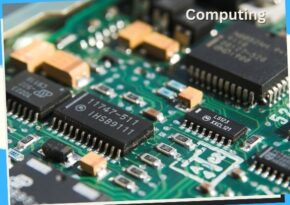
Secure Your Transactions: Implementing Edge Computing for Point-of-Sale Systems
Discover how implementing edge computing in point-of-sale systems enhances transaction security, protecting sensitive customer data from cyber threats.
Safeguarding Point-of-Sale Systems with Edge Computing 

In the world of retail, security is paramount, especially when it comes to point-of-sale (POS) systems. With the advent of edge computing, retailers now have a powerful tool at their disposal to enhance the security of their POS systems while ensuring seamless transactions for customers. In this comprehensive guide, we’ll explore how you can implement edge computing to secure your POS systems and protect sensitive customer data.
Understanding Edge Computing for Secure POS Systems
What is Edge Computing?
Edge computing is a distributed computing paradigm that brings computation and data storage closer to the source of data generation. By processing data locally at the edge of the network, edge computing reduces latency, conserves bandwidth, and enables real-time insights and actions.
Why Edge Computing for Secure POS Systems?
In the realm of retail, where millions of transactions occur daily, securing POS systems is critical to protecting sensitive customer information such as credit card details and personal data. By leveraging edge computing, retailers can process payment transactions locally, reducing the risk of data breaches and ensuring compliance with security standards.
Implementing Edge Computing for Secure POS Systems
1. Deploy Secure Edge Devices
Begin by deploying secure edge devices at each point-of-sale terminal within your retail environment. These devices act as the edge of the network, processing payment transactions locally and encrypting sensitive data before transmitting it to the central processing unit. Ensure these edge devices are hardened against security threats and regularly updated with the latest security patches.
2. Utilize Encryption Protocols
Implement robust encryption protocols to protect sensitive customer data during payment transactions. Utilize industry-standard encryption algorithms such as AES (Advanced Encryption Standard) to encrypt data both at rest and in transit, ensuring that it remains secure from unauthorized access or interception.
3. Implement Tokenization for Data Protection
Implement tokenization techniques to further protect sensitive customer data within your POS systems. Tokenization replaces sensitive data such as credit card numbers with randomly generated tokens, reducing the risk of data exposure in the event of a breach. Ensure that tokenization keys are securely managed and stored to prevent unauthorized access.
4. Enable Secure Authentication Mechanisms
Implement secure authentication mechanisms to verify the identity of users accessing POS systems. Utilize strong passwords, biometric authentication, or multi-factor authentication to prevent unauthorized access and protect against credential theft. Regularly review and update authentication policies to mitigate the risk of security vulnerabilities.
5. Monitor for Anomalies and Intrusions
Utilize edge computing capabilities to monitor POS systems for anomalies and intrusions in real-time. Deploy intrusion detection systems and anomaly detection algorithms at the edge of the network to identify suspicious activity and potential security breaches. Implement automated alerting mechanisms to notify security personnel of any security incidents requiring immediate attention.
6. Secure Network Connectivity
Secure network connectivity between edge devices and backend systems to prevent unauthorized access and data exfiltration. Implement firewall rules, network segmentation, and virtual private networks (VPNs) to restrict access to sensitive data and control communication between edge devices and central servers. Regularly audit network configurations and access controls to ensure compliance with security policies.
7. Regular Security Audits and Updates
Conduct regular security audits and vulnerability assessments to identify and remediate security weaknesses within your POS systems. Perform penetration testing to simulate real-world cyberattacks and evaluate the effectiveness of security controls. Stay vigilant and proactive in applying security updates and patches to both edge devices and backend systems to protect against emerging threats.
Overcoming Challenges and Considerations
Compliance with Regulatory Requirements
Ensure compliance with regulatory requirements such as the Payment Card Industry Data Security Standard (PCI DSS) when implementing edge computing for secure POS systems. Familiarize yourself with relevant data protection regulations and industry standards to ensure that your security measures align with legal and compliance requirements.
Resource Constraints on Edge Devices
Consider resource constraints on edge devices when designing security solutions for POS systems. Balance security requirements with performance considerations to avoid impacting transaction processing speed or system responsiveness. Optimize security configurations and implement lightweight security protocols where possible to minimize resource overhead.
User Training and Awareness
Invest in user training and awareness programs to educate employees about the importance of security in POS systems. Train staff on best practices for securing POS terminals, recognizing potential security threats, and responding to security incidents effectively. Foster a culture of security awareness and accountability to empower employees to play an active role in protecting customer data.
Implementing edge computing for secure POS systems
An essential for retailers looking to safeguard sensitive customer data and maintain trust and confidence in their brand. By leveraging edge computing capabilities, retailers can process payment transactions locally, encrypting data at the point of capture and reducing the risk of data breaches. Embrace the power of edge computing today and enhance the security of your POS systems to protect against evolving cyber threats.
Benefits of Implementing Edge Computing for Secure Point-of-Sale Systems
- Enhanced Security: Protect customer data and payment transactions with robust encryption and security protocols, minimizing the risk of data breaches.
- Reduced Latency: Process transactions locally at the edge, minimizing latency and ensuring faster response times for seamless customer experiences.
- Improved Reliability: Ensure continuous operation of POS systems, even in the event of network disruptions or server outages, to minimize downtime and lost sales.
- Compliance: Meet regulatory requirements and industry standards for data protection and privacy, ensuring compliance with laws such as PCI-DSS.
- Cost Savings: Reduce bandwidth costs and reliance on centralized servers by offloading processing tasks to edge devices, optimizing resource usage and efficiency.
- Scalability: Scale your POS infrastructure effortlessly to accommodate growing transaction volumes and business needs, without sacrificing performance or security.
- Offline Capabilities: Enable POS systems to function offline or in remote locations, allowing businesses to continue operations even in challenging environments.
- Customization: Tailor POS solutions to specific business needs and requirements, with the flexibility to deploy customized applications and services at the edge.
- Real-Time Insights: Gain valuable insights into customer behavior and transaction trends, enabling data-driven decision-making and targeted marketing strategies.
- Competitive Advantage: Stay ahead of competitors by offering secure and reliable POS solutions that prioritize customer trust and satisfaction.
Case Studies: Real-Life Success Stories
- Retail Chain: By implementing edge computing for its POS systems, a retail chain reduced transaction processing times by 50%, leading to improved customer satisfaction and increased sales.
- Hospitality Industry: A hotel chain enhanced guest experiences and streamlined check-in/check-out processes by deploying edge computing solutions for its POS systems, resulting in shorter wait times and higher guest satisfaction scores.
- Restaurant Franchise: A restaurant franchise improved order accuracy and speed of service by leveraging edge computing for its POS terminals, leading to higher customer retention and increased revenue.
- Grocery Store: A grocery store chain minimized checkout wait times and optimized inventory management by implementing edge computing for its POS systems, resulting in improved operational efficiency and reduced costs.
- Entertainment Venue: An entertainment venue enhanced security and reduced fraud by deploying edge computing solutions for its POS terminals, enabling real-time transaction monitoring and fraud detection.
- E-commerce Platform: An e-commerce platform integrated edge computing capabilities into its POS systems, enabling secure and seamless online transactions for customers, leading to increased trust and loyalty.
- Banking Institution: A banking institution improved branch efficiency and customer service by implementing edge computing for its POS terminals, enabling faster transaction processing and improved access to banking services.
- Transportation Services: A transportation company optimized ticketing and payment processes by leveraging edge computing for its POS systems, resulting in smoother transactions and improved customer satisfaction.
- Event Management: An event management company enhanced ticketing and registration processes by deploying edge computing solutions for its POS terminals, leading to faster check-ins and improved attendee experiences.
- Healthcare Facility: A healthcare facility improved patient billing and record-keeping processes by implementing edge computing for its POS systems, ensuring accurate and secure transactions for medical services.
Key Takeaways
- Prioritize Security: Implement robust encryption and security measures to protect customer data and payment transactions from cyber threats.
- Minimize Latency: Process transactions locally at the edge to minimize latency and ensure faster response times for seamless customer experiences.
- Ensure Compliance: Adhere to regulatory requirements and industry standards for data protection and privacy, such as PCI-DSS.
- Plan for Reliability: Design POS systems with built-in redundancy and failover mechanisms to ensure continuous operation and minimize downtime.
- Optimize Resource Usage: Offload processing tasks to edge devices to reduce reliance on centralized servers and optimize bandwidth usage.
- Customize Solutions: Tailor POS solutions to specific business needs and requirements, with the flexibility to deploy customized applications and services at the edge.
- Leverage Real-Time Insights: Gain valuable insights into customer behavior and transaction trends to inform decision-making and marketing strategies.
- Stay Agile: Continuously monitor and adapt POS systems to evolving security threats and business needs to maintain a competitive edge.
- Train Personnel: Provide training and support to staff members to ensure proper use and maintenance of edge computing-enabled POS systems.
- Invest in Scalability: Scale POS infrastructure effortlessly to accommodate growing transaction volumes and business expansion without sacrificing performance or security.
FAQ
Q1: What is edge computing, and how does it enhance POS systems?
A1: Edge computing involves processing data closer to the source, enabling faster transaction processing, improved security, and reliability for POS systems.
Q2: How does edge computing improve security in POS systems?
A2: By processing transactions locally at the edge, edge computing minimizes exposure to network vulnerabilities and ensures data encryption and protection.
Q3: Can edge computing be integrated with existing POS systems?
A3: Yes, edge computing solutions can be seamlessly integrated with existing POS systems, enabling enhanced security and performance without requiring a complete overhaul of infrastructure.
Q4: What are the regulatory requirements for POS systems?
A4: Regulatory requirements vary by industry and location, but common standards such as PCI-DSS govern data protection and privacy for POS transactions.
Q5: How does edge computing minimize latency in POS transactions?
A5: By processing transactions locally at the edge, edge computing reduces the need to transmit data to centralized servers, minimizing latency and ensuring faster response times.
Q6: What types of businesses can benefit from edge computing-enabled POS systems?
A6: Businesses across various industries, including retail, hospitality, banking, healthcare, and entertainment, can benefit from edge computing-enabled POS systems to enhance security, reliability, and customer experiences.
Q7: What are the long-term benefits of implementing edge computing for POS systems?
A7: Long-term benefits include improved security and compliance, reduced downtime and maintenance costs, enhanced customer experiences, and a competitive advantage in the marketplace.
Q8: How does edge computing enable offline capabilities for POS systems?
A8: Edge computing allows POS systems to process transactions locally, even in offline or remote environments, ensuring uninterrupted service and customer satisfaction.
Q9: What are the key considerations when selecting edge computing solutions for POS systems?
A9: Key considerations include security features, scalability, compatibility with existing systems, ease of integration, and support for regulatory compliance standards.
Q10: How can businesses get started with implementing edge computing for secure POS systems?
A10: Businesses can start by assessing their security and compliance requirements, evaluating edge computing solutions, and partnering with experienced providers to design and deploy secure POS systems that meet their needs.
Conclusion

Key Phrases
- Edge computing for secure POS systems
- Payment security enhancement
- Next-gen POS security solutions
- Cyber threat protection
- Fraud risk mitigation
- Retail security transformation
- Data confidentiality in POS
- POS system integration
- Transaction security optimization
- Edge computing applications in payments
Best Hashtags
- #EdgeComputing
- #SecurePOS
- #PaymentSecurity
- #RetailSecurity
- #FraudProtection
- #CyberThreats
- #DataConfidentiality
- #TransactionSecurity
- #POSIntegration
- #EdgeTech
Save/Share this story with QR CODE
Disclaimer
This article is for informational purposes only and does not constitute endorsement of any specific technologies or methodologies and financial advice or endorsement of any specific products or services.
 Need to get in touch?
Need to get in touch?

We appreciate your reading. 
1.) 

Your DONATION will be used to fund and maintain NEXTGENDAY.com
Subscribers in the Philippines can make donations to mobile number 0917 906 3081, thru GCash.
3.) 
4.) 
AFFILIATE PARTNERS

World Class Nutritional Supplements - Buy Highest Quality Products, Purest Most Healthy Ingredients, Direct to your Door! Up to 90% OFF.
Join LiveGood Today - A company created to satisfy the world's most demanding leaders and entrepreneurs, with the best compensation plan today.

 Business, Finance & Technology
Business, Finance & Technology















